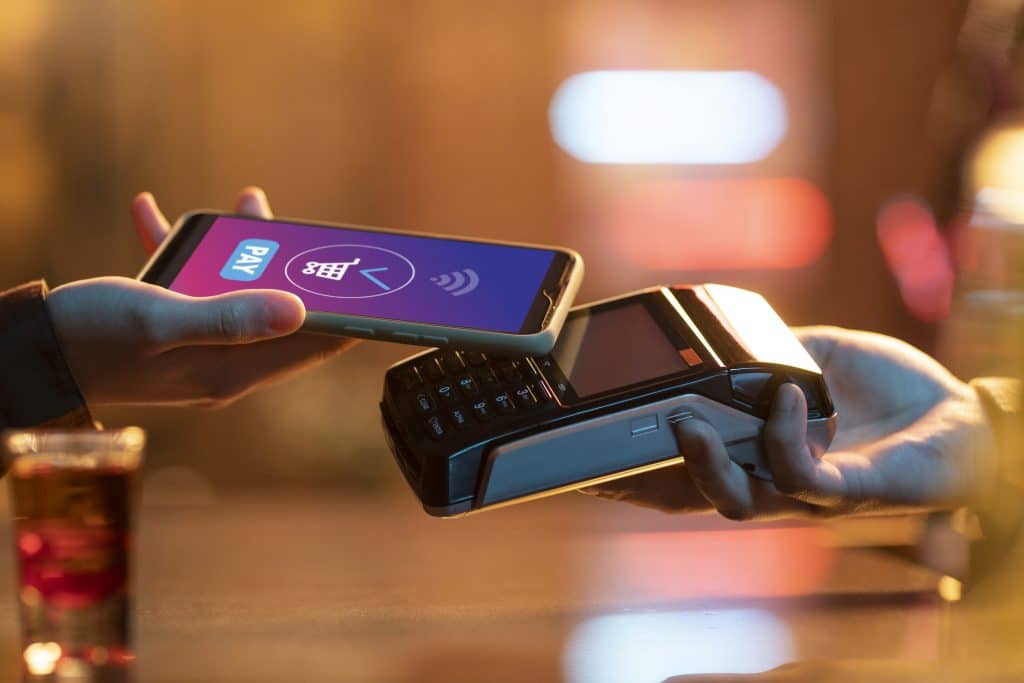Growing mobile payment apps: Revolutionizing transactions

Anúncios

The rise of growing mobile payment apps has significantly transformed how we make transactions today.
These apps offer unparalleled convenience, enhanced security, and improved customer engagement, making them an essential tool for businesses aiming to streamline their operations.
Anúncios
As mobile payments continue to gain popularity, they are reshaping the way consumers handle their finances, making it crucial for businesses to stay ahead of the curve.
In this article, we’ll delve into the growing significance of these apps and how they are revolutionizing transactions, offering greater flexibility and shaping the future of payments.
What are mobile payment apps?
Mobile payment apps are applications designed to allow users to conduct transactions via their smartphones or tablets.
Anúncios
These apps provide a convenient and efficient way to pay for goods and services with just a few taps, making them an increasingly essential tool in today’s digital world.
The rise of growing mobile payment apps is reshaping how we handle our finances, shifting us away from traditional methods like cash and credit cards towards digital transactions.
These apps have become an integral part of our daily routines, especially as technology continues to advance.
With mobile payment apps, you can make purchases or send money to others anytime and anywhere, all from the convenience of your mobile device.
The convenience of not needing cash or physical credit cards is part of the reason growing mobile payment apps have gained such widespread adoption.
As this technology becomes more embedded in our lives, users can enjoy the seamless management of their finances on the go.
Growing mobile payment apps allow you to link your bank accounts, credit cards, or even digital wallets, enabling you to make purchases quickly and securely.
This transition to cashless payments marks a shift in how we engage with money, offering more flexibility and control over our spending habits.
Key Characteristics of Mobile Payment Apps
Mobile payment apps stand out for their ability to combine simplicity, security, and efficiency, making them incredibly popular among consumers. Here are some key features that define growing mobile payment apps:
- Ease of Use: These apps are designed with user-friendly interfaces, making them accessible to individuals of all ages and technical backgrounds. Navigating through these apps is intuitive, which contributes to their rapid adoption.
- Secure Transactions: The security of your personal and financial data is paramount. Growing mobile payment apps use encryption technology and multi-factor authentication to ensure that transactions are protected against fraud and unauthorized access.
- Instant Transfers: One of the most attractive aspects of mobile payments is the ability to send money instantly to friends, family, or businesses. No more waiting for checks to clear or for cash to be deposited, growing mobile payment apps enable real-time payments that eliminate delays.
- Loyalty Programs: Many of the leading mobile payment apps integrate rewards programs. These programs allow users to earn points, discounts, or cashback with each transaction, enhancing the overall user experience and encouraging repeat usage.
These core features play a significant role in the widespread adoption of growing mobile payment apps, offering both consumers and businesses a more efficient and secure way to manage financial transactions.
Examples of Popular Mobile Payment Apps
As the market for growing mobile payment apps continues to expand, several apps have risen to prominence, each catering to different user needs. Here are some of the most widely used mobile payment apps:
- PayPal: A global leader in digital payments, PayPal allows users to send and receive money across various platforms, both domestically and internationally.
- Venmo: Known for its social integration, Venmo is widely used for easy money transfers between friends and family, allowing users to share and comment on payments.
- Apple Pay: Seamlessly integrated into Apple devices, Apple Pay allows users to make contactless payments in stores, online, and within apps, offering a quick and secure payment solution for iPhone and Apple Watch users.
- Google Pay: Designed for Android users, Google Pay provides a straightforward method for in-store, online, and peer-to-peer transactions, helping users manage their payments and loyalty cards all in one app.
With so many options available, growing mobile payment apps give users the flexibility to choose the app that best fits their device preferences and financial needs.
Whether you’re an iOS or Android user, or looking for specific features like instant transfers or rewards programs, there is an app designed for your lifestyle.
The rise of mobile payments in everyday transactions
The adoption of mobile payments has rapidly surged in recent years, transforming how we shop, pay bills, and split expenses.
With the advancement of technology, growing mobile payment apps now allow users to complete transactions at the touch of a button, bringing unparalleled convenience to everyday life.
This shift is not only about ease of use; businesses have quickly embraced the technology, recognizing its importance in meeting customer demands for faster, more flexible payment options.
As more vendors integrate mobile payment systems, consumers are becoming increasingly comfortable with using them for everything from coffee runs to grocery shopping.
Factors Contributing to the Rise of Mobile Payments
Several factors have fueled the rise of mobile payments:
- Smartphone Accessibility: The growing accessibility of smartphones makes mobile payments more feasible for a broader audience.
- Time-Saving Convenience: Mobile payments offer a quicker way to complete transactions, a crucial benefit in today’s fast-paced world.
- Contactless Technology: Innovations like NFC (Near Field Communication) ensure faster and safer transactions.
- Pandemic Impact: The COVID-19 pandemic accelerated the shift towards cashless payments as people sought safer, touch-free alternatives.
This widespread adoption reflects a broader trend toward digital convenience. With many businesses now accepting mobile payments, customers can enjoy a smoother, faster transaction experience.
Benefits of Mobile Payments
Mobile payments offer several clear advantages. They make transactions fast and easy, allowing users to send or receive money in seconds.
With advanced security measures like encryption and biometric authentication, these apps provide a safer alternative to traditional methods, reducing the risk of fraud.
Mobile payment apps also help users better manage their finances by providing tools to track spending and organize payments.
As the technology evolves, growing mobile payment apps will continue to simplify and improve how we engage with money.
Key features of successful mobile payment apps

Successful mobile payment apps share several core features that enhance both usability and security, attracting and retaining users over time.
These features not only ensure the convenience of transactions but also contribute to a positive user experience, which is crucial for app success.
Understanding these key elements can help users choose the right mobile payment solution.
One of the most important aspects of a successful mobile payment app is its user experience. A clean, intuitive interface allows users to navigate the app and complete transactions quickly.
Additionally, the ability to personalize settings to match individual preferences enhances usability and increases engagement with the app.
Essential Features of Mobile Payment Apps
Here are some crucial features that make mobile payment apps effective:
- Security measures: Top apps use encryption and multi-factor authentication to protect user data.
- Instant notifications: Users receive alerts for transactions, enhancing transparency and security.
- Multi-platform support: Successful apps are usually available on various platforms, including iOS and Android.
- Easy integration: Many apps can connect seamlessly with bank accounts and payment cards, simplifying the funding process.
Moreover, effective customer support is vital for mobile payment apps. Users should have access to help through various channels, such as live chat, email, or phone. Quality customer support can enhance user trust and retention.
Innovative Offerings
As the mobile payment apps market continues to evolve, innovation plays a critical role in maintaining user engagement.
Many apps now incorporate features like loyalty programs, rewarding users with points or discounts for every transaction.
Others use artificial intelligence to analyze spending habits and offer personalized recommendations, further enhancing the user experience.
With these continuous innovations, growing mobile payment apps are set to offer even more seamless, secure, and convenient ways for users to manage their financial transactions.
Security concerns with mobile payment apps
As mobile payment apps become increasingly popular, concerns regarding security are also growing. While these apps provide unmatched convenience and ease of use, it’s essential for users to understand the potential risks involved.
Protecting personal and financial information while using these apps is critical to ensuring a safe and secure experience.
One of the primary security concerns is the exposure of personal and financial data. Many users worry about the possibility of identity theft or unauthorized transactions.
Although app developers continuously improve security features, users must also take proactive steps to protect themselves by practicing good security habits.
Common Security Risks
Several security risks are associated with mobile payment apps, which users should be aware of:
- Data Breaches: Weak security practices or vulnerabilities in the app can lead to data breaches, putting personal information at risk of exposure to unauthorized parties.
- Phishing Scams: Fraudulent messages or emails that mimic legitimate communications can trick users into revealing sensitive details like passwords, usernames, or payment information.
- Malware: Malicious software installed on devices can steal personal data or monitor activities without the user’s knowledge, compromising the security of financial transactions.
- Wi-Fi Vulnerabilities: Using public Wi-Fi to make payments increases the risk of hacking. These networks may not be secure, allowing cybercriminals to intercept data transmitted during transactions.
To minimize these risks, users should ensure their apps have the latest updates. Regular updates often include security enhancements that protect against new threats.
Also, using strong, unique passwords and enabling two-factor authentication can significantly increase account security.
Best Practices for Safe Mobile Payments
By following these best practices, users can significantly enhance the security of their mobile payment transactions:
- Download Reputable Apps: Always download apps from trusted sources, such as the Apple App Store or Google Play Store, to avoid malicious software.
- Monitor Transactions: Regularly review your transaction history to spot any unauthorized charges early, and report them immediately.
- Enable Biometric Security: Many mobile payment apps offer biometric options like fingerprint or facial recognition for secure access.
- Use Secure Networks: Limit mobile payment transactions to secure, private networks to avoid exposing your information on public Wi-Fi.
Staying vigilant and informed about security best practices will allow users to enjoy the convenience of mobile payment apps while keeping their personal and financial information safe from threats.
Future trends in mobile payments
The future of mobile payments looks incredibly promising as technology continues to evolve. With more people relying on their smartphones for everyday transactions, we can expect several trends to shape the way we pay.
One major trend is the increasing use of artificial intelligence (AI) in payment processing. AI can help personalize the user experience by analyzing spending habits and providing tailored recommendations.
This personalization not only enhances user engagement but also streamlines the payment process.
Emerging Technologies Influencing Mobile Payments
Several emerging technologies are set to make a significant impact on mobile payments:
- Blockchain: This technology can enhance security and transparency in transactions, making it harder for fraudsters to manipulate payment data.
- Internet of Things (IoT): Smart devices will allow for seamless and automatic payments, making transactions quicker and more convenient.
- 5G Technology: The rollout of 5G networks will improve the speed and reliability of mobile payments, enabling real-time transactions.
- Biometric Authentication: Fingerprint and facial recognition technology will continue to enhance security for mobile users, making unauthorized access increasingly difficult.
As we move forward, the integration of these technologies will likely redefine user expectations. Consumers will seek convenience and speed, calling for solutions that simplify transactions. Retailers will need to adapt to meet these demands effectively.
Global Adoption of Mobile Payment Solutions
The global landscape for mobile payments is also changing. In many emerging markets, mobile payments are becoming a primary method of transaction, driven by a lack of traditional banking infrastructure.
This shift presents opportunities for growth in regions where mobile devices outnumber traditional bank accounts.
Furthermore, partnerships between financial institutions and tech companies will spur innovation.
By working together, these companies can develop new features and functionalities that cater to the specific needs of consumers.
Staying informed about these future trends in mobile payments can help users embrace new technologies and enjoy a more efficient payment experience.
The evolution of this payment method will undoubtedly influence our daily lives and financial interactions.
How businesses can leverage mobile payment technology

Businesses today have a unique opportunity to leverage mobile payment technology to enhance their operations and customer experience.
By integrating mobile payments, companies can streamline transactions and offer convenience to their customers. This shift can lead to increased sales and customer loyalty.
Many businesses are adopting mobile payment systems to meet consumer demand for speed and flexibility.
For example, restaurants can use mobile payment apps to allow customers to pay their bills directly from their phones, reducing wait times and improving overall satisfaction.
Benefits of Mobile Payment Technology for Businesses
Integrating mobile payment technology offers several key advantages:
- Enhanced customer experience: Customers appreciate the convenience of quick transactions, making them more likely to return.
- Reduced transaction costs: Mobile payments can lower fees associated with card processing and cash handling.
- Real-time sales data: Businesses can access valuable insights into customer preferences and spending habits.
- Increased security: Mobile payments often come with enhanced security features, making transactions safer for both businesses and customers.
Furthermore, businesses can benefit from promotional opportunities by integrating loyalty programs within their mobile payment solutions. Customers can earn rewards directly through the app, fostering engagement and encouraging repeat business. This not only enhances the customer experience but also drives sales.
Implementing Mobile Payment Solutions
To successfully implement mobile payment technology, businesses should consider the following steps:
- Choose the right platform: Research different mobile payment solutions to find one that fits your business needs.
- Train staff: Ensure employees understand how to use the mobile payment system efficiently and assist customers when necessary.
- Promote the service: Make customers aware of the new payment option through marketing campaigns and in-store signage.
- Monitor and adapt: Regularly assess the performance of the mobile payment system and make changes based on customer feedback.
By proactively embracing mobile payment technology, businesses can stay competitive in the evolving market and meet the needs of today’s consumers.
This approach not only simplifies transactions but also creates a more engaging shopping experience.
As we’ve explored, growing mobile payment apps are undeniably revolutionizing the way transactions are conducted, transforming financial interactions for both consumers and businesses.
These apps provide a level of convenience, security, and customization that has fundamentally reshaped how people manage and make payments on a daily basis.
From contactless transactions to the integration of advanced technologies like AI and blockchain, the future of mobile payments promises even greater ease of use and enhanced functionality.
For consumers, the advantages are clear: faster payments, secure transactions, and even loyalty rewards that incentivize continued use.
For businesses, growing mobile payment apps offer opportunities for increased sales, lower transaction costs, and improved customer engagement.
As more and more companies adopt these technologies, they will be able to provide a smoother, more personalized experience, positioning themselves as leaders in an increasingly competitive market.
The growing mobile payment apps trend is not just a passing phase but a critical shift in how we handle money, pushing both technology and consumer behavior into new directions.
With AI-driven personalization, blockchain-enhanced security, and the power of 5G technology, the next evolution of mobile payments is already on the horizon, and those who stay ahead of the curve will reap the rewards.
In conclusion, the integration of mobile payment apps into our everyday lives is set to continue growing, and both individuals and businesses must embrace these technologies to stay competitive and efficient.
By prioritizing security, convenience, and customer engagement, businesses can build trust and loyalty while simplifying their payment processes.
As we move forward, growing mobile payment apps will play an even more significant role in shaping the future of financial transactions, creating a more seamless, secure, and user-friendly payment landscape.
For more detailed insights into the mobile payments market, you can explore these resources from Market Pay and Business of Apps.
FAQ – Frequently Asked Questions about Mobile Payment Technology
What are mobile payment apps?
Mobile payment apps allow users to make transactions using their smartphones, providing a convenient way to pay for goods and services.
How can businesses benefit from mobile payment technology?
Businesses can enhance customer experience, reduce transaction costs, and gain real-time sales data through mobile payment integration.
What security measures are in place for mobile payments?
Mobile payment apps typically use encryption, biometric authentication, and other security features to protect user data and prevent fraud.
What trends are shaping the future of mobile payments?
Trends include the adoption of AI, the use of blockchain for security, and increased integration with smart devices, enhancing payment convenience.
Liked the article?





